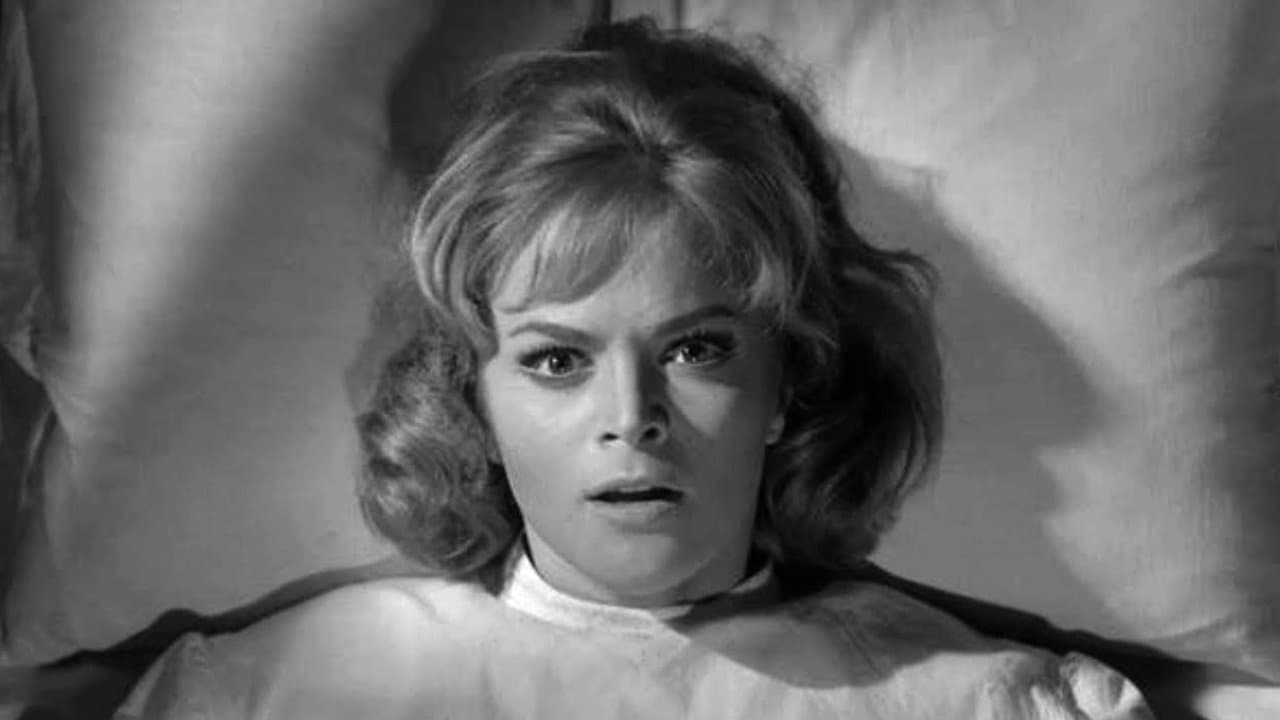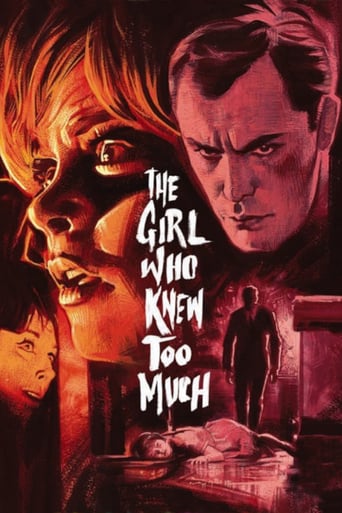

There are at least two film versions of this story. One is the English translation known as "The Evil Eye" a watered-down version of the original Italian construction called "The Girl Who Knew Too Much." The two versions differ in score and plot points. This review pertains to my viewing of "The Girl Who Knew Too Much."I would describe the film as a suspenseful murder mystery, one of the first Italian Giallos. Probably the best element is that wonderful B&W lighting consisting of overhead and side lighting that puts faces and objects in deep shadows. Outdoor settings at night are especially creepy. Water-glass camera effects suggest hallucination and delusion. And there are some terrifically unsettling POV camera shots.In one sequence the lead character enters a building at night. She arrives by elevator on an upper floor. No one else is visible, but hallway lights hanging from the ceiling sway back and forth, and someone is talking to her. As she approaches the room to which she had previously been invited, the light in the room suddenly goes dark. We see her silhouette as she stands at the entrance of the darkened room.The script contains relatively few characters. The two leads are a young female American tourist named Nora Davis (Leticia Roman) and a youthful Italian doctor named Dr. Bassi (John Saxon). The plot is acceptable. But I successfully guessed the identity of the killer fairly early which, to me, suggests that the plot could have been a little more subtle and the murderer less obvious. On the other hand, part of the plot was repeated in a subsequent Giallo that I had previously seen; so maybe I zeroed in on the killer's identity here as a result of the later film.There's some humor in this film as well. At one point the resourceful Nora makes use of talcum powder in an attempt to trap the killer, with unplanned results. Various murder mystery clichés in combo with explicit humor suggests that the story is something of a spoof of the genre.Casting is acceptable. Overall acting is only fair, except for the wonderful performance of Valentina Cortese. Didn't notice any problems with editing or prod design; and costumes really hark back to the 1960s. Love that jazzy score.This film deserves at least one viewing for those who enjoy murder mysteries. It has some negatives, but they are definitely outweighed by an interesting story and especially by the terrific visuals.
... View MoreBava pays explicit homage to Hitchcock in this fun, mostly light hearted black and white mystery. An American girl vacationing in Rome witnesses what might be a murder (or is it her overactive imagination, spurred on by her love of cheap mystery novels?). And before you know it, she's the possible target of a serial killer. The black and white photography is beautiful, but Bava tones his style down just a bit, and it works; the photography compliments the story, without swamping it,. There are weak spots, like an annoying voice over that insists on explaining what the images are making very clear by themselves, and performances that are uneven (especially in supporting roles). But, the bottom line is, if it wasn't in Italian, one could even believe this was a Hitchcock film, which is a pretty high compliment...
... View MoreThe American fan of mystery novels Nora Davis (Letícia Román) travels from New York to Rome to spend vacation with her mother's friend Ethel Windell Batocci (Chana Coubert). In the airplane, she accepts a pack of cigarettes from the passenger on the next seat and in the airport she finds that the man is a drug dealer. When she arrives at Ethel's place, she meets Dr. Marcello Bassi (john Saxon) and finds that the old lady is in the deathbed. During the night, Ethel has a heart attack and dies; Nora runs to the hospital to call Marcello. However, she is attacked and robbed in a staircase by a thief and faints; while awaking, she witnesses a stabbed woman and a man after her. In the hospital, nobody gives credit to her words. In the funeral, the stranger Laura Craven- Torrani (Valentina Cortese) introduces herself as a friend of Ethel and invites Nora to stay in her apartment while she travels to Switzerland to meet her husband. Nora accepts the invitation and decides to investigate the murder; she believes that the serial-killer of the so called Alphabet Murders is chasing her and she will be the next victim."The Girl Who Knew too Much" is an overrated melodramatic thriller of Mario Bava visibly inspired in Alfred Hitchcock. The awesome cinematography in black and white using shadows gives a fantastic atmosphere to the streets of Rome. However, the hysterical Nora Davis is annoying in many moments and the attitudes of Dr. Marcello Bassi are silly and naive. The conclusion of Dora about the cigarette of marijuana is ridiculous. My vote is five.Title (Brazil): Not Available
... View MoreComing out in 1963, The Girl Who Knew Too Much is not as ground-breaking as other Mario Bava efforts but it's still every bit as stylish and suspenseful. The plot of the film, convoluted and filled with twists and red herrigns galore, anticipates the giallo cycle of the late 60's. Of course one year later the director would practically define the style with Blood and Black Lace, introducing other genre staples like the black-gloved killer, the garish colours and the gore but that doesn't detract from the ifluential status of this proto-giallo.As the title imples, The Girl Who Knew Too Much is with one foot firmly set in Hitchcock territory, but whereas Hitch films had a tendency of trying to be too many things at once (little bits of comedy, romance etc) something I always considered distracting, Bava allows nothing to come between him and his goal: a suspenseful horror thriller.The chiaroscuro photography is simply beautiful to look at, light and shadow play off each other in expressive ways, not unlike film-noir. Leticia Roman's face is at times only half-lit to stress her confusion, while in other set-pieces dark figures stand out against fully lit backgrounds. Bava is famous for being one of the best visual directors in the history of the medium for good reason. His black and white work is as good as his colour films.Minor quibbles I had with the film include that many scares turn out to be false, the first person narration (another film-noir influence) and the implied possibilities in the ending *was it all a dream?* Leticia Roman and John Saxon hit it off with great chemistry, the DP work is fantabulous, the opening 15-20 minutes leading up to the first murder are among the best 20 minutes in 60's horror and this an all around accomplished horror film that deserves every fan's attention.
... View More